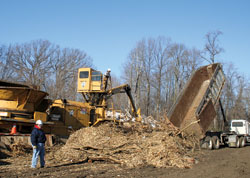Religious Vocations Supplement
Sisters of Providence use biomass energy to care for the Earth

Providence Sister Dana Augustin stands next to natural materials that will soon be re-used in a biomass energy process to provide heat for her congregation’s motherhouse at Saint Mary-of-the-Woods. (Submitted photo)
By Dave Cox (Special to The Criterion)
SAINT MARY-OF-THE-WOODS—St. Theodora Guérin, foundress of the Sisters of Providence of Saint Mary-of-the-Woods, came from France to a dense forest in western Indiana in 1840 to sow the seeds of hope: hope that a new congregation of women religious could flourish, hope that the word of God could be spread among pioneers, hope that children could be educated.
In 1854, in a letter to another Sister of Providence, she wrote, “Well, my daughter, ours is a preparation for the generation that will succeed us, and eminent good will be done this way by us. You may not live to see it, but you will have sown the seed, and your Sisters will come to reap what will have been sown.”
Many generations of St. Theodora’s daughters have continued to sow the seeds of hope through a variety of ministries in devotion to works of love, mercy and justice in service among God’s people.
Indeed, one of the congregation’s most prominent ministries today grew from roots literally planted by St. Theodora.
She and other founding sisters worked hard to maintain their version of organic gardens, which provided food for the sisters. Mother Theodore, often in frail health, would work in the gardens by planting seeds, pulling out weeds and harvesting crops.
Today, those roots of organic gardening and crop control thrive in the congregation through the White Violet Center for Eco-Justice and ministries that maintain a commitment to being creative re-users of natural resources and protectors of the Earth’s gifts.
Sister Dana Augustin, previously a member of St. Mary Parish in Richmond, is involved in a complementary ministry that, in some ways, brings full circle the practice of reusing materials for new benefit.
She serves as supervisor of Biomass Processing at Saint Mary-of-the-Woods.
Just as Mother Theodore and her sisters had to rely on fallen trees, limbs and other materials to burn for heat, so will today’s sisters when the biomass energy process is soon fully operational.
Biomass energy uses all plant and plant-derived materials, such as wood and other forest residues, grasses, husks and straw from crops, and some construction debris. The emission standards are the same as for natural gas. The system will provide heat and electrical energy at significant, long-term cost savings.
Perhaps St. Theodora never envisioned this opportunity for the sisters of this generation, but for Sister Dana, it is a natural progression from her lifestyle before she joined the congregation.
“Recycling is something we had always done in my family. I have always had some consciousness of doing things in an eco-friendly way,” she said.
Her awareness increased as she progressed through her initial formation with the Sisters of Providence.
“The eco-justice piece comes up a lot during formation. It’s part of the postulancy training. It is part of our study of spirituality during our canonical novitiate,” she said.
Here are examples of how the Sisters of Providence biomass project is reusing materials:
- Pallets, crates and other materials from manufacturing companies are being gathered to use for fuel.
- Charred wood from a grocery store fire is being sawed. Larger pieces are being planed and used for lumber. Smaller pieces are being used for cabinetry and trim at two new hermitage houses being built with mostly recycled materials.
- Mineral oil is being accepted from manufacturers, cleaned and resold to them to reduce dumping the oil into the ground.
- Cooking oil is being collected and transformed into biodiesel fuel where it can be used without any kind of alteration to a standard diesel engine.
“Our recycling program is growing a lot. I see this entire campus as a shrine to Mother Theodore, but also as a model of sustainability where we try to use all of our materials by recycling as much as we can,” Sister Dana said.
“As far as moving in a direction for a sustainable Earth, we have to work with industry. We have to say, ‘There are different ways you can operate that are more beneficial for you and for our environment. Here are some things you might want to look at.’ I would hope the Sisters of Providence could be a model for that kind of work,” she added.
And Sister Dana believes opportunities abound for women in all eco-justice endeavors.
“There are many needs to be met. What the Sisters of Providence have done for me through the years is open my eyes to opportunities in all kinds of places to work for justice. I think we’re going through a change right now in our world and I want to be part of that change,” Sister Dana said.
Thus, the seeds and renewable energy sowed by St. Theodora through her leadership and in her gardens during the congregation’s foundation years continue to harvest fruit for today’s Sisters of Providence who are sowing their own seeds for the future. †
